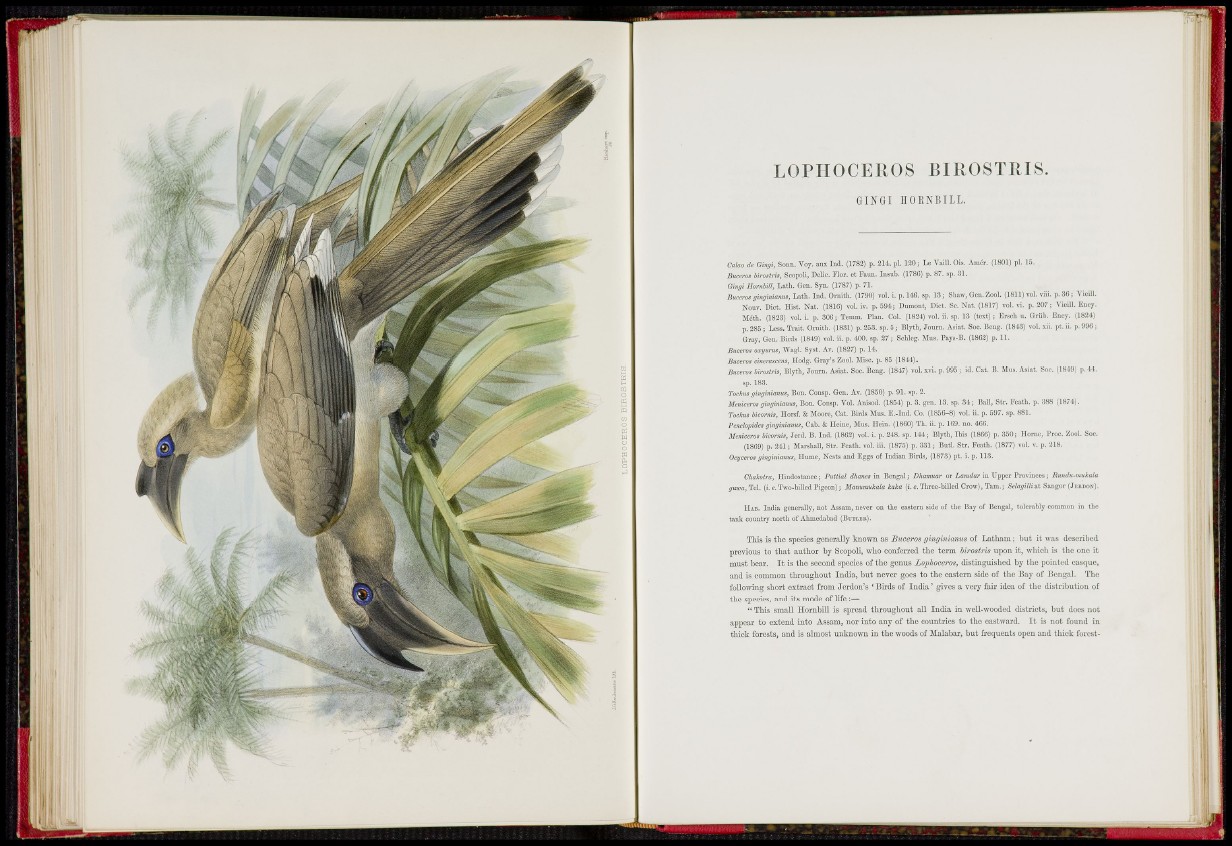
LOPHOCEROS BIROSTRIS.
G I N G I IIOENBILL,
Calao de Gingi, Sonn. Voy. mix Ind. (1782) p. 214. pi. 120; Le Vaill. Ois. Amor. (1801) pi. 15.
Buccros birostrís, Scopoli, Delic. Mor. et Faim. lusub. (1786) p. 87. sp. 31.
Gingi HornbiU, Lath. Gea. Sjn. (1787) p. 71.
Biiceros ginginianvs, Lath. Ind. Omith. (1790) TOI. i. p. 146. sp. 13; Shaw, Gen. Zool. (1811) vol. viii. p. 3 6 ; Vieill.
Nouv. Diet. Hist. Nat. (1816) vol. iv. p. 59-1; Dumont, Diet. Sc. Nat. (1817) vol. vi. p. 207; Vieill. Ency.
Méth. (1823) Tol. i. p. 306; Temiii. Plan. Col. (1824.) vol. ii. sp. 13 (text); Ersch u. Griib. Enoy. (182-1)
p. 285 ; Less. Trait. Omith. (1831) p. 253. sp. 5 ; Blyth, Journ. Asiat. Soc. Bcng. (1843) vol. xii. pt. ii- p. 99G;
Gray, Gen. Binls (1849) vol. ii. p. 400. sp. 27; Schleg. Mua. Pays-B. (18C2) p. 11-
fíuceros oxijurus, Wagl. Syst. Av. (1827) p. 14.
Buceros ciTuirascens, Ilodg. Gray's Zool. Misc. p. 85 (184-1.).
BMeros birostris, Blyth, Journ. Asiat. Soe. Beng. (1847) vol. xvi. p. 995; id. Cat. B- Mus. Asiat. Soc. (18-t9) p.-H.
sp. 183.
Tockus ginginiams, Bon. Consp. Gen. Av. (1850) p. 91. sp. 2.
Menictros ginginiaTms, Bon. Consp. Vol. Anisod. (185-1) p. 3. gen. 13. sp. 34; Ball, Str. Fcatb. p. 388 (1874).
Tockus bicornis, Ilorsf. & Moore, Cat. Birds Mus. E - lnd. Co. (1856-8) vol. ii. p. 597. sp. 881.
Penelopides ginginianus, Cab. & Heine, Mus. Ilcin. (1860) Th. ii. p. 1G9. no. 466.
Meniceros bicomis, Jerd- B. Ind. (1862) vol. i. p. 248. sp. 144; Blyth, This (1866) p. 350; Home, I'roe. Zool- Soc.
(1869) p. 211; Marshall, Str. Peath. vol- iii. (1875) p. 331; Butl. Str. Feath. (1877) vol. v. p. 218.
Ocyceros ginginianus, Hume, Nests and Eggs o£ Indian Birds, (1873) pt. i. p. 113.
Chakotra, Ilindostanec; PuUial dhanea in Bengal; Dhamuar or Lamdar in Upper Provinces; Rundu-mukala
gwua,'Tc\. (i.e. Two-billed Pigeon); Manumukala kaka (t. e. Three-hi lied Crow), Tarn.; SelagHlia.i Sanger (JERPON).
HAD. India generally, not Assam, never on the eastern side of the Bay of Bengal, tolerably common in the
tank country north of Ahmedabad (BUTLER).
T h i s is t l i e species general l y k n own as Buceros ginginiamis of Latham; but it was described
p r e v i o u s to that author by Scopoli, w h o conferred the term, birostris upon it, which is tlic one it
m u s t bear. It is the second species of t h e genus Lophooeros, distinguished by the pointed casque,
a n d is c ommo n throughout India, but never goes to the eastern side of the Bay of Bengal. The
f o l l o w i n g short extract f rom Jcrdon' s ' B i r d s of India' gives a ver y fair idea of the distribution of
t h e spccics, and i t s m o d e of l ife: —
" Thi s small Ilornbill is spread throughout aU India in well-wooded districts, but docs not
a p p e a r to extend into Assam, nor int o any of the countries to the eastward. It is not found in
t h i c k forests, and is a lmost unknown in t h e woods of l l a l a b a r , b u t frequents ope n and thick forest